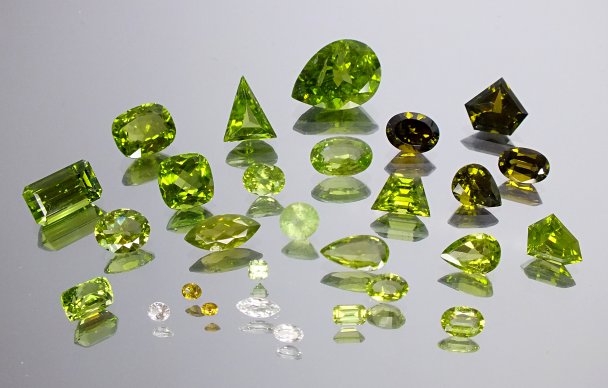 |
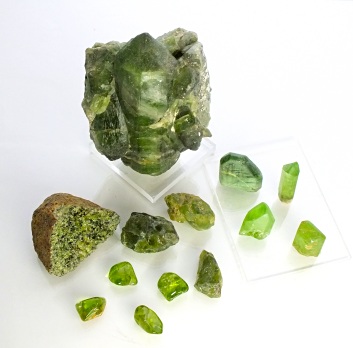 |
| ���l�ȐF�����̃J�b�g���ꂽ�y���h�b�g�@0.08�|17.90ct Faceted peridots in various hue |
�l�X�Ȏp�̃y���h�b�g���� Peridot crystals in various shape |
��S�iPeridot, Olivine�j
 |
 |
| ���l�ȐF�����̃J�b�g���ꂽ�y���h�b�g�@0.08�|17.90ct Faceted peridots in various hue |
�l�X�Ȏp�̃y���h�b�g���� Peridot crystals in various shape |
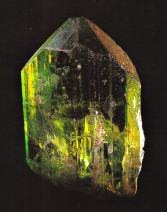 |
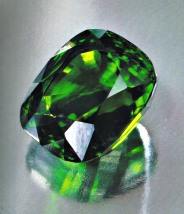 |
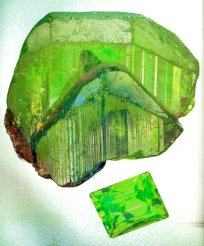 |
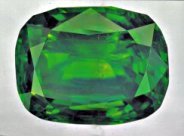 |
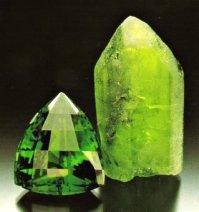 |
| �����@5cm�@Zabargat �����z�R�w�Z������ Ecole des Mines Paris�@France |
�ő勉�̃��[�X�@284.85ct Zabargat�@Island A.Ruppenthal�@Collection Idar�]Oberstein |
����4.1cm�ƃ��[�X10.92ct Zabargat�@Island |
�r���}�Y�y���h�b�g
154.15ct Burma Peridot |
�p�L�X�^���̃y���h�b�g ���[�X�@172.53ct�@�����@6cm Suppat, Pakistan |
| �A�����J���R�j������ American Museum of Natural History, New York | ||||
| ���w�g�� (Formula) |
�����n �@(Crystal System)�@ |
���[�X�d�x �@(Hardness)�@ |
��d �@�@(Density)�@ |
���ܗ� �@(Refractive Index)�@ |
| �@(Mg,Fe)2SiO4 | �������n (Orthorhombic) |
6½ - 7 | �@3.22-40 | 1.635-695 |
���O�ɂ��āiAbout the name�j
�@�y���h�b�g�͒n���̎�v�ȑ���z���ł����S�̔����������Ȍ����ł��B
��S��(Olivine)�̖��͂��̐F���I���[��(��S)�̗t�̐F�Ɏ��Ă��邱�Ƃ���t����ꂽ���̂ł��B
�@��̑O�܂ł͕���z�������ɃI�����B��(Olivine)�ƌĂ�Ă��܂����B
�@���݂ł̓A���r�A��ŕ���Ӗ����� "Faridat" ���ꌹ�Ƃ��ČÃt�����X��� Péritot �ƌĂꂽ�y���h�b�g����Ζ��Ƃ��čL���g����p�ɂȂ�z�����A��Ζ��̃I�����B��(��S��)�Ƃ͋�ʂ���Ă��܂��B
�@�����Ɛ̂�17,18���I���܂Ńy���h�b�g�̓g�p�[�Y�Ƃ��Ă�Ă��܂����B
�y���h�b�g�̎�Y�n�ł������g�C�̃U�o���K�[�g�����g�p�\�X���ƌĂ�A�̌@���ꂽ����������g�p�V�I���ƌĂ�Ă�������ł��B
�@�����Ȃǂ̌Â������Ńg�p�[�Y�Ƃ��鎞�A���ۂ̓y���h�b�g���w���ƍl����ׂ��ł��傤�B
�@����ɉ��F����тт��͐̂̓M���V�A��́hkhrusos�F���F�g�Ɉ���ŃN���\���C�g�iChrysolite�j�Ƃ��Ă�Ă��܂����B
�@���݂ł����X���F�g�������y���h�b�g�̓N���\���C�g�ƌĂ�邱�Ƃ�����܂��B
�@Peridot, the gem variety of the olivine group, is usually found in the mantle only as small crystals. Olivine is the name given to this series of mineral group for their color resemble to olive leaf.
�@In the past, both gemstone and rock were called olivine, which has been gradually superseded by the classic french name péritot, a derivation of the arabic word "faridat", meaning gemstone. Peridot has been called as Topazios, named after the name of island in the Red Sea (now Zabargad) once called "Topazos". Therefore a gemstone called topaz in ancient literature is great probably a peridot. In addition, yellowish peridot has been and even today sometimes called as chrysolite upon Greek word "khrusos : golden " and " lithos : stone".
�����ƎY��iFormation and occurrence�j�@
�@�n���[���̑啔�����߂�}���g���㕔�͖w�Ǟ�S��ŏo���Ă���ƍl�����Ă��܂��B
���ہA�ΎR�̕��Œn��ɉ^�ꂽ��S�̌�����A�قڞ�S��������Ȃ�ΎR�e�������E���̉ΎR�n�тɔ�������܂��B
�@�g�߂ȏ��ł͎O���n���C�̗n�◬�����������C�݂̍��I���Ɍ�������������܂��B
�c�O�Ȃ���唼�͉��̎ʐ^�̂悤�ȗ����̏W���ŁA�ƂĂ���Ƃ��Ă͎g���܂���B
�@��ƂȂ�悤�ȑ傫�������Ȟ�S�̌����́A��͉ΎR�����ɂ��n������^�ꂽ��S�₪�������Ɨ₦�đ傫�Ȍ����ɐ��������ꍇ�ł��B�@���E�̔����قŌ�����100�J���b�g���z����悤�ȑ傫���������y���h�b�g�͍g�C�̃U�o���K�[�g����r���}�ƋߔN�������ꂽ�p�L�X�^���̎R�x�n�тō̂�܂��B
�@��ʂɉΎR�����ŕ��o�����n��͋}���ɗ₦�邽�ߌ����͍ח��̏W���̂ɂȂ��Ă��܂��܂��B
�@�]���ĕ�Ύ��̞�S�ΎY�n�͋ɂ߂Č����܂��B
��v�ȎY�n�̓A���]�i�B�T���E�J�����X�����̓T�^�I�ȗ�ł��B���A�ח��̌����c���瓧���ȕ�Ύ������݂̂����o������5�J���b�g�ȏ�̑傫�ȃ��[�X�͋H�ł��B
�@�����������̐���ʂɍ̂�邽�ߐ��E�̃y���h�b�g��80%�ȏ����������Y�n�ł��B�@�@�@�@�@�@
�@�����̎Y�n�ł͐ڐG�ϐ���p��M����p������S��w�ɑ傫���������P�������������܂����B
�@The upper mantle of the earth consists of dense, dark rocks composed essentially of peridotite together with eclogite and dunite. In fact, peridot crystals are found abundant in volcanic zones throughout the world, but almost all peridot crystals are found as fine graines and can not be used as gemstone. Transparent crystals large enough to be faceted occurs when peridotite is cooled down slowly. However such locality is quite rare and Peridot Mesa of San Carlos Apache reservation is that rare case. There, gemmy fragments are picked up from fine grained nodule. San Carlos is the dominant supplier (more than 80%) of gem peridot, although most of the stones are small, rerely exceeding 5 carats.
�@Large peridot crystals and gemstones over 100 carats displayed at world's museums are mined at classic location of Zabargad Island, Pyaunggang, north of Mogok, Burma and at recent discovery at Suppat, Pakistan in Hindu-ksh Mountains. In these localities, big peridot single crystals are formed by metamorphism or hydrothermal reaction.
�@
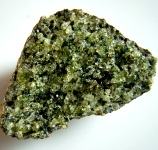 |
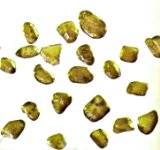 |
 |
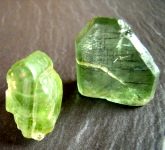 |
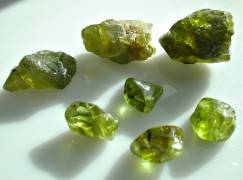 |
| ��S�ΉΎR�e�@3cm Peridot bomb Girona Spain |
�����₩��̐����I �@������ �@�O� waterworne peridot Miyake Island, Japan |
�y���h�b�g���� 78x56x33mm Peridot crystal aggregate Sapat Pakistan |
��Ύ��@�y���h�b�g���� Gemmy crysals 17/22mm Pakistan |
�����ЂƐ����I 10-25mm rough & waterworne peridot�@ San Carlos, Arizona, USA |
���E�̃y���h�b�g�Y�n
�U�o���K�[�g���iZabargat�@Island�j

�gPeridotite Hill"�̌��i
A View of Zabargat Island��D�⒆�̐̂̍B��������@
Entrance of ancient mine in dolomite�ő勉�̌����@���@20cm large crystal
�@�X�~�\�j�A�����R�j������
Smithsonian Institution���}�m�t��������̕���i
192.75ct�@5.2x3.5cm�v
State�@Treasury�@of Russia�U�o���K�[�g�Y���E�ő勉�̃��[�X
(310ct)�@�ƃA���]�i�Y(8.9ct)�@
The largest peridot(310ct) Zabargat
8.9ct stone San Carlos, Arizona�@�@�@�@�U�o���K�[�g�Y�̌����ƃ��[�X�@146ct
Zabargat peridot cystals and looses
�@�����h�����R�j������
�@�@�@Natural History Museum, London�U�o���K�[�g�Y�̌���2�p�ƃ��[�X9.5ct
(Zabargat Peridot crystal 2cm
and faceted stone 9.5ct)
Ray Hill Collection
�@�G�W�v�g�암�A�X�[�_�������ɋ߂��g�C�ɕ����ԏ����A�U�o���K�[�g���ł͋I���O1500�N�̐̂���������y���h�b�g���Y���邱�ƂŒm���Ă��܂����B�@
�@�X�~�\�j�A�������ّ��̐��E�ő�̃��[�X���n�߂Ƃ��āA���E�̔����ق≤���̕���i�����鋐��ȃy���h�b�g�̑唼�͂��̓�����̂ꂽ���̂ł��B
�@�i�C���쒆���Ɏ�{�e�[�x���\���Ă����Ñ�G�W�v�g����������V��������ɓ��ł̕�̎悪�n�܂����Ƃ����܂��B
�@�Ȍ�M���V�A�n�̃v�g���}�C�I�X���̎���ɂ͂��̓���"Topazos"���ƌĂ�A�̏W���ꂽ�̕��18���I�܂Ńg�p�V�I���ƌĂ�Ă��܂����B
�@�\���R�̎��ケ�̓��ɗ������������҂ɂ��St.John's���ƌĂ�A�̎悳�ꂽ�̕�́A�P�����̑吹���⃔�@�`�J���̐��╨�Ƃ��āA���B�e�n�Ɏc����Ă��܂��B
�@�܂��I�X�}����g���R�̉������y���h�b�g�͑��d���ꂽ��Ő��E�ōł��L���ȃy���h�b�g�̕���i�̃R���N�V�������C�X�^���u�[���̃g�v�J�s�{�a�Ɏc����Ă��܂��B
�@�̌@�́A���̃G�W�v�g�����ɂ��f���I�Ɍp�����ꂽ��ɉi�炭�Y�ꋎ��Ă��܂������A20���I�����ɍĔ�������A�h�g�C�z�R��Ёh�ɂ��ϋɓI�ȍz�R�J���Ō����Ȍ����𑽐��Y�o���܂����B
�@�̌@�͑�Q�����E����܂ōs���܂������A�z���̌͊��ƃG�W�v�g���{�ɂ�鍑�L���Ƃ�1958�N�ɕR�ƂȂ�܂����B
�@���̖��͋ߔN�ł̓U�o���K�[�g���ƌĂ�܂��B
�A���r�A�ꓙ�̃Z���n�̌���ɂ͕������q����������܂���B
�@���������ē��̖��� �gZbrgt�h �Ǝq���݂̂ŒԂ��A�ꉹ�͓K�X��������邽�� �gZabergat�g�gZebirget�h ���X���l�Ȕ���������܂����A��������A���r�A��Ńy���h�b�g���Ӗ����܂��B
�@Off the Egyptian coast in the Red Sea, southern Egypt, near the Sudan Boarder, lies Zabargad Island, which has been known for the oldest peridot mine since 15 centuries B.C., worked and controled directly by Egyptian pharaohs. During Ptlemios dynasty, this island, which was highly inaccesible due to frequent fog, was called Topazos by seafarers, meant in Greek word "seek", and mined gems has been called topazos too, until 18th century.
�@During the Middle Ages, the Crusaders called this island "St.John's island and brought peridot back to Europe; some of these gems are preserved in European cathedrales. Peridot was highly prized late during the Ottoman Empire(1300-1918). Turkish Sultans amassed the world's largest collection of them. In Istanbul's Topkapi Museum, there is a gold throne decorated with 955 peridot cabochons ranging up to an inch across.
�@Peridot mine of Zabargat island has been forgotten several hundreds of years after the decay of Egyption dynasty and was rediscovered in early 20th century. The Red Sea Mining Company began mining in 1924 with relatively modern facilities and has supplied fine gem peridots until mine was nationalized by Egyptian government in 1958.
�@�U�o���K�[�g�̃y���h�b�g�̎Y�� (Occurrence of peridot)
�@�L����5����km���炸�̃U�o���K�[�g���̒n���͒n����ōł��ڍׂȒ������s��ꂽ�ꏊ�ł��B
1923�N�ȗ��A1970�N��,1980�N��Ɛ��x�ɓn��n���������s���܂����B
�@���A����̓y���h�b�g�̎Y�n�Ƃ������R����ł͂���܂���B
�@�g�C�̓A�t���J�嗤�ƃA���r�A�����Ƃ��ďo�������̂ł����A���݂ł����X�ɍL�����Ă���r��ɂ���܂��B
�@�}�_�K�X�J������A�t���J���C�݉����ɁA�n���C����X�ɃA���r�A�����Ɏ��鐔��km�̒���Ȓn�тŌ��݁A�n����ōł������Ȓn�k�ϓ����N���Ă��܂��B
�����ăU�o���K�[�g���͂܂��ɁA���̒n�k�ϓ��ɂ���ďo�������ł���A���E�ŋ��w�̃y���h�b�g�͂��̕��Y���Ƃ��Đ��������Ƃ����킯�ł��B
�@�g�C���J���n�߂�2600���N�́A�n��8km���̐[���܂ŏ㏸���Ă����}���g���㕔�̞�S��̗��N�ɂ���ďo�����̂��U�o���K�[�g���ł��B
�@�y���h�b�g�̌����̓y���h�b�g�u�ƌĂ��W��235m�̞�S��̂̎R�̓쐼�Ζʂ̋T��̋�Ԃɔ�������܂��B
�@���̞͂�S��͂Ђǂ��������Ď֖�≻���Ă��܂��B
����͒n������C��ւ̃}�O�}�̊ѓ��Ŕj�ӂ��ꂽ��S�₪750�`950���̍����ɉ��M����A�X�ɉ��M���ꂽ�C���̍�p�Ő��E�ł��H�ȃy���h�b�g�̑傫�Ȍ����ւƐ��������ƍl�����Ă��܂��B
�@This island is one of the most throughly studied 5 square km known. It is not because of peridot mining but because of geological interest in the Red Sea area, which one of the most dynamic tectonic features on the earth's surface.
The Red Sea forms part of a rift system that includes the Gulf of Aden and the East African rift in the south, and the Gulf of Suez and the Gulf of Aqaba in the north. The northern Red Sea is a continental rift that has developed nearly to the point where sea floor spreading initiates. Active sea floor spreading is occurring in the southern end of the Red Sea. Zabargat has yielded information on the nature of the upper mantle in a young rift zone with lithosphere transitional from continental to oceanic. Studies of the peridotite suggest an origin of more than 30km-depth.
�@Gem peridot occurrences on Zabargat Island are limited to the eastern slope of the southern peridotite, the 235m high Peridot Hill. The gem peridot is found in open cavities in the veins which consist highly serpentinized peridotite, which is thought to be the result of seawater contamination during the final stages of the mantle intrusion when the peridotite penetrated the seafloor and at temperatures of about 750��to 950��C , resulting in metasomatic mineralization and forming the gem peridot.
�r���}�̃y���h�b�g (Burma Peridot)
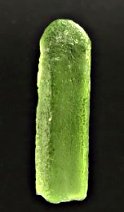 |
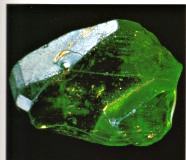 |
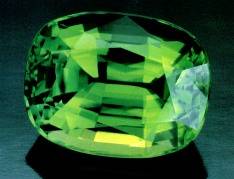 |
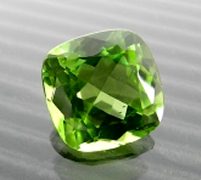 |
| �\�ʂ��Z�H���ꂽ�����@2.6cm�@ Etched prismatic crstal |
����̌��� �iTabular crystal)�j |
���[�X(Faceted stone) 36ct | 5.95ct 11x11mm |
| Pyanggaung, Burma | |||
4.5cm 4.1cm Pyaung-gaung�@�y���h�b�g�z�R 4.5cm 6.5cm
�@ �@���r�[��T�t�@�C�A,�X�s�l��,���x���C�g,���X,���E�ŗL���̕�ΎY�n�ł���r���}�̃��S�N�n���͂܂��A1960�N��ȍ~�A���E�ōł����i���̃y���h�b�g�Y�n�Ƃ��Ă��m����悤�ɂȂ�܂����B
�@Mogok�̒��̖k��10km�APyang-gaung �̑��ɂ��т���W�� 2250m �� Kyaukpong �R�̖k���Ζʂ̞�S��Ղ̋T�����Ɍ�������������܂��B
�@���r�[��T�t�@�C�A�͑嗝���ϐ���p�����n���ɁA����ɓ����y�n�ɂ̓g�p�[�Y��g���}�����A�A�N�A�}�������̉ԛ���y�O�}�^�C�g�����̍z�����Y���郂�S�N�ł����A���̂�����10�q�k�ɂ́A���[����ł����S��̕��o������A����炢����̒n���w�I�ɑS���قȂ�n������A���E�ő�ꋉ�̕�Ό������Y����Ƃ����A���ق̓y�n�ł���ƁA���߂Ċ��Q���邵������܂���B
���̎Y�n�ɂ��Ă̏ڍׂȕ͖w�ǂ���܂��A�S���ɕx�ޔ����₪�M�ϐ���p�Ŏ֖�≻������Ւ��Ɍ���������A�ʐ^�̂悤�ɑ����̌������������Z�H��p���Ă��邱�Ƃ���A�قڃU�o���K�[�g���̃y���h�b�g�Ɠ��l�A�M�����̍Č�����p�ŏo�������̂Ǝv���܂��B����E���ȍ~�A�s����ȍ���̂��߂ɑ�K�͂ȍ̌@���s���܂��A�t�߂̏Z���ɂ��ׁX�Ƃ����̌@�ő傫�ȏ��������������100�J���b�g���z���郋�[�X���U���I�Ɏs��ɏo���܂��B
�@Mogok gem tract in Burma, renowned gem locality with outstanding ruby, sapphyre, spinel, rubelite etc. etc. has been known since 1960 as one of the best gem peridot locality, too.
35km north from Mogk, on the north-western slope of Kyaukpong Mountain, 2250m high in Pyaunggaung village is the gem peridot deposit. Although there are no geological report on the deposit, gem peridot crystal is discovered in loose, weathered , greenish serpentine, which was formed by metamorphism of a ferruginous gabbbro. Transformation of the former basic rock probably by hydrothermal action changed the parent rock without influencing the huge, magnesium-rich gemstone crystals, some weighing up over 100 carats.
�@It is thought that many excelent peridot crystals and jewelleries since Renaissance to 19th century, found in European museums are from this locality.
�@
�p�L�X�^���̃y���h�b�g (Pakistan Peridot)
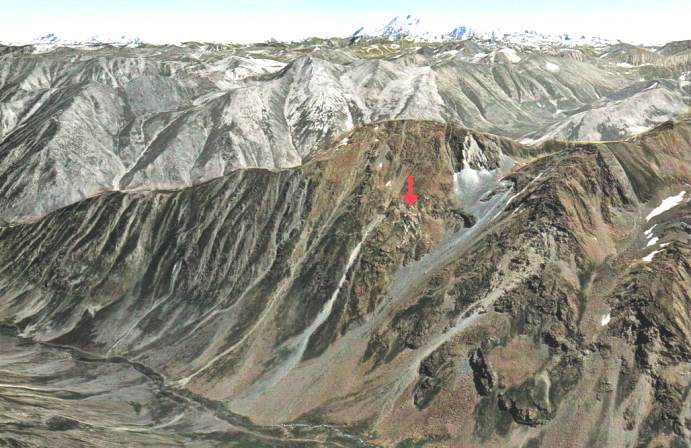 |
 |
| �W��4500m�̋}�s�ȎΖʂɂ���y���h�b�g�Y�n�̉q���ʐ^ ���i�̎R�̓i���K�E�p���o�b�g(8,125m) Satellite view of peridot mines at alt. 4500m with distant view of Nanga Parbat peak�i8,125m�j |
�y���h�b�g�z���ɉ����ĕ��ԍz�v�̃e���g�̉q���ʐ^ Satellite image of miner's summer tents along peridot veins |
| Sapat Gali, Pakistan | |
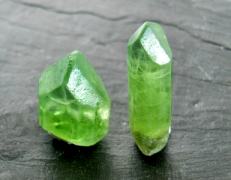 |
 |
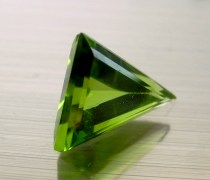 |
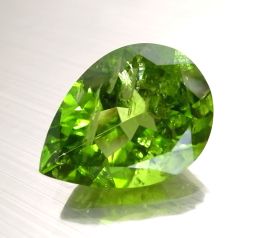 |
| 20x19x10mm 23x9x8mm | 6.96ct 13.4x11.2mm | 5.25ct 14.0x11.0mm | 17.9ct 20.6x15.0mm |
�@1992�N�āA�p�L�X�^���k�����̎R���ɕ�Ύ��̃y���h�b�g�̌����Y�n����������܂����B
�悭������Ȋ댯�ȏꏊ�ɍz����T�����Ă��Ɗ��S����݂̂ł��B�B
�@�W��4500���̍����̂��ߍ̌@���o����͉̂Ă�3�����قǂɌ����Ă��܂����A����100�����ɕ�炷���l�B��200�l���瑽�����ɂ�2000�l�����A�ł��߂�������n��7����,���ꂩ��k����2���Ԃ̓��̂�������Ă���Ă��č̌@���Ă��܂��B�@
�ꌎ�ŕ���100k���̌������̌@����܂����A�t�@�Z�b�g���̌�����3kg���x�ɉ߂��܂���B
�@������20�`30�J���b�g�̑傫�ȃ��[�X���H�ł͂Ȃ��ő�ł�300�J���b�g���z����L�^�I�ȃ��[�X���̂��ȂǁA������E�ł��L���̃y���h�b�g�̎Y�n�ƂȂ�܂����B
�@����ȍ̌@��������ߔN�ł͍̌@�ʂ͌������Ă��܂��B�@���A�z����12�q�̒����ɐL�тĂ��܂�����A���������̂悤�ȑ傫�Ȍ������Ăюp��������\��������܂��B
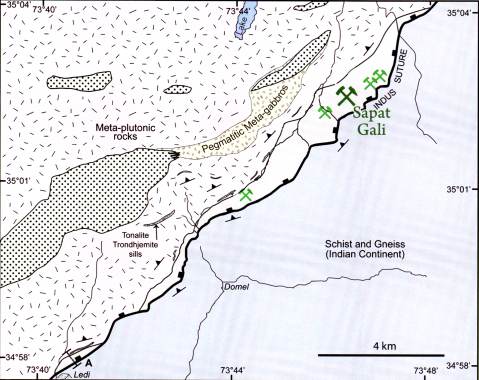 |
�@ �ڍׂȒn�������ɂ��A�T�p�b�g�̃y���h�b�g�͂��悻5000���N�O�̎n�V���ɃC���h�嗤�� ���[���V�A�嗤�ɏՓ˂��A���N�����ۂ̒n�k�ϓ��Ő������ꂽ���Ƃ��������܂����B �@�n���}�ɖ��炩�Ȃ悤�ɁA�Њ�ƕЖ��₩�琬��C���h�E�v���[�g�ƃg�[�i����̒��[���� �̉ΐ���̂��琬�郆�[���V�A�E�v���[�g�Ƃ̊Ԃ̍ג������Ԃɕ��P�q�A�����P�Q�q�ɋy�� ���-������� Harzburgite�i�n���c�o�[�W���C�g�F�Ε��P�Ξ�S��j�A�P�A������� �_����S���琬���̂��`������A�����ɞ�S�Ό��������o�����ƍl�����܂��B �@( Mineralogical Record 2020 Nr. 51-6 pp789) �@ |
�@
���̕t�߂ł͈ȑO���獂�i���̃}�O�l�T�C�g ( �H��y�z�@�F�@MgCO3 ) �̎Y�n�Ƃ��Ēm���Ă��܂����B
�@�̏W���ꂽ�������������A�U�o���K�[�g����r���}�̃��S�N�Ɠ����A��S�₪�ϐ���p�Ŏ֖�≻������ɔM���̊ѓ��ɂ��傫�Ȍ��������������ƍl�����܂��B
�@ ���͂̌��ʂł̓t�H���X�e���C�g��90���A�t�@�C�A���C�g��10������Ȃ錋���ŁA�j��̃��[�h���B�b�q�@�i Ludvigite�@�F Mg2FeBo5 )�̃C���N���[�W�����������Ό����܂��B
�@In 1992 summer, gem peridot vein was discovered in the Northern Mountains of Pakistan.
Today crystal specimens and facetted stones are seen abundant at gem and mineral fairs.
The mine is located at the altitude of 4500m high and mining is possible only 3 months in summer.
�@200 to 2000 viillagers living around 100km from mine climb the distance of 7 hours ride on horse then 2 days walk from the nearest village for mining.
�@Maximum 100kg of rough is mined every month, which yield only 3kg of facetable crystal.
20 to 30ct faceted stone is common and maximum over 300ct of faceted stone was recorded to appeal this locality as the most exciting peridot mine, ever found.
�@According to the geological survey of this locality , this area had been known as the high quality magnesite locality. The collected peridot crystal specimens tells clearly that big gemmy crystal is formed by hydrothermal intrusion to the peridotite, which had been serpentinized by metamorphism action., as in case of Zabargat and Pyaunggaung, Burma.
The chemical analysis revealed that peridot crystal consists of 90% foresterite and 10% fayalite with acicular ludvigcite inclusion.
�@
�A���]�i�B�@�T����J�����X�@�iSan Carlos, Arizona, U.S.A.)
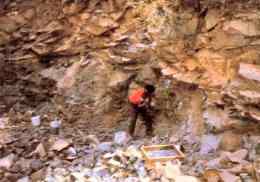 |
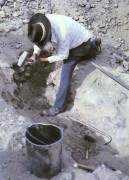 |
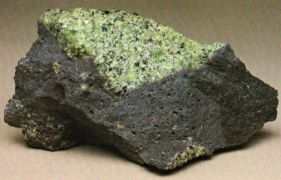 |
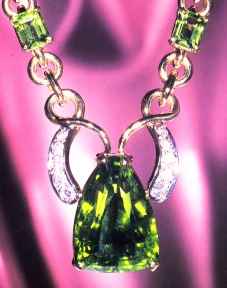 |
| ������n�����ƂŃy���h�b�g�c������o�� Peridot mining mainly by hand tools |
������̃y���h�b�g�c��@��20cm peridot nodule in basalt 20cm |
�ő��35ct�̃y���g�b�g The largest faceted stone 35ct American Gem Society Collection | |
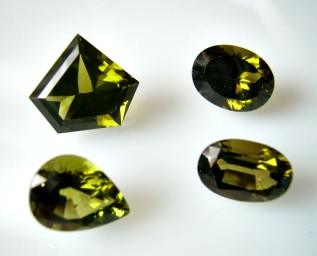 |
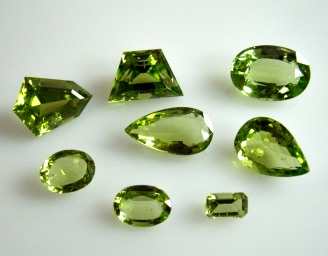 |
|
| �T���E�J�����X�Y�Ê��F�̃y���h�b�g�@2.85�`5.64ct Dark brownish green peridot from San Carlos |
��ʂɐl�C�̂���W�[�Z�̃��[�X�@0.54 - 4.45ct Popular pale green to deep green faceted stones |
�z�R�̗��j�@(History of the deposit)
�@�A���]�i�B�T���E�J�����X�̃A�p�b�`���C���f�B�A���͉��S�N���̂��狏�Z��ō̂��̐��r�[�Y���̑����p�Ɏg���Ă��܂����B
�@�����ꂪ��̃y���h�b�g�ł���ƌ����ɕ��ꂽ�̂�1904�N�A�e�B�t�@�j�[��ΓX�̃N���c���m�ɂ����̂ł����B
�����͑�ςȕ]���ƂȂ��āA���Ȃ�̗ʂ̃y���h�b�g���̌@����Ďs�����킵�܂������A�ߏ�Ȑ��Y�ɂ��M���͉߂�����,���i���\�����Ă����܂��Y�ꋎ���Ă��܂����B
�@���肵���̌@�Ǝs��ł̎��v�Ƃ����������̂�1960�N��̂��Ƃ�,����Ȍ�͐��E�̎��v��80���ȏ���߂�y���h�b�g�̐��Y�n�ƂȂ��Ă��܂��B
�̌@�͓~�̗�����10������3���܂ł̔��N�Ԃ̂ݍs���܂��B
�����̐��Y�ʂ�600kg�̃J�{�V������r�[�Y���̃��t��12�|15kg�̃t�@�Z�b�g���̃��t�������܂��B95%��5�J���b�g�ȉ��̑傫���ł��B
�@Many years before the Peridot Mesa deposit was recognized by the international trade as gem source (Kunz, 1904), the area was mined by the Apache Indians and the stones were sued exclusively among tribal members, From 1904 to 1909, however, mining was carried out at an almost feverish pace, and soon the market was choked with an excess of available gems. This tended to reduce prices and hold them down, while decreasing buyer interest in the stone. Consequently, mining activity declined rapidly and for many years was almost nonexistent.
�@It was in 1960's that market demand and stable mining recovered, then Peridot Mesa, Arizona, U.S.A. maintained the position of dominant supplier of gem peridot with more than 80% of world market share.
�@The mining is carried out from October to March during cool winter season only. Monthly production is presently about 600kg of cabochon and tumbling quality material and 12-15kg of facetable rough. Approximately 95% of the latter consists of pieces smaller than 5ct.
�n���ƎY��@(Geology and occurrence)�@
�@ �@�T����J�����X�̃y���h�b�g�͕�t�F�A�ŗL���ȃc�[�\���̖k80km�̃y���h�b�g�E���T(��n)�ƌĂ�錺����n�◬����1cm����30cm�قǂ̑傫���̍ח��̞�S�Βc��Ƃ��Ĕ�������܂��B�@
���炭�V�����O�I�����l�I�ɂ����Ă̐V�����ΎR���Ń}�O�}���n������㏸����ۂɓr���̞�S�₪��荞�܂ꂽ�ƍl�����܂��B
�@�y���h�b�g�E���T�͑傫����5.4��4.4km�łP�`30m�̌���������܂��B
�@�̌@�͕K�v�ɉ����Č�����n�����u���h�[�U�[�ʼn܂����A�唼�͊ȒP�ȓ���Ɛl�̎�Ńy���h�b�g�c�����肾��,�傫�ȕ�Ύ��̕������I�蕪�����܂��B
�����郋�[�X�͕��ʂ͂Q�`�R�J���b�g���x�ł��B
�ߋ�100�N�̍̌@�̗��j��ʂ��ē���ꂽ�ő�̃��[�X��35�J���b�g�ł����B
�@1990�N���납�烁�T�̉��̃L���j�I���i���J�j�ƌĂ��n��ł̍̌@���n�܂�܂����B
�|�P�b�g��̌�����̊���ڂ���5�`35�J���b�g�̑傫���̃��[�X�������錋���c���������悤�ł��B
�@San Carlos deposit is located about 80km north of Tucson in the basalt capping called Peridot Mesa. It appears to have extruded as the result of a single volcanic event, tought to be of late Tertiary or Quarternary age. The peridot is found abundant as fine grained nodule of 1cm to 30cm. Peridot Mesa extends approximately 5.6km in a north-west dirction and about 4.4km along a northwest-southeasgt axis. The basalt ranges in thickness from 3m near the cone vent to over 30m where the flow filled natural depressions in the underlying Gila congromerate, a flat horizontal to slightly folded sedimentary structure of early Pleistocene age.
�@The basalt is tough and does not yield readily to hand tools, blasgting is done sparingly and only when absolutely necessary. A light bulldozer is sometimes used to work freshly blasted areas, remove top soil, and maintain or build roads ; otherwise, no heavy equipment is employed and the vast majority of the mining is done almost entirely by hand.
�@From 1990. mining at Canyon, beneath the Mesa started. Nodules which yield 5-35ct faceted stones are recovered from pocket-like basalt fissures.
�j���[���L�V�R�B�@�L���{�[����z�[���iKilbourn�@Hole,�@New�@Mexico�AU.S.A.�j
�@
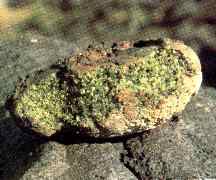 |
 |
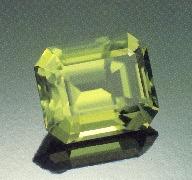 |
| ��Ύ��̃y���h�b�g�������܂މΎR�e (Basalt-coated xenolith-bomb,often containing gem-quality peridot.) |
128��26ct�̌����\�ȃ��t���̂ꂽ�ΎR�e (The best bomb yielded two pieces of cuttable rough 128 and 26ct) |
1.43ct�̖����̃��[�X (Faceted flawless stone of optimum color) |
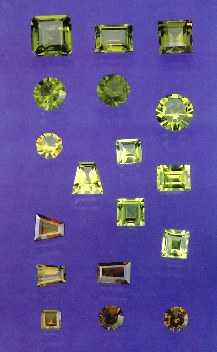 |
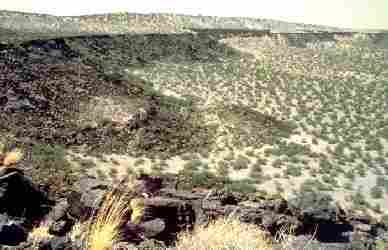 |
 |
| �L���{�[���Y�y���h�b�g�̐F�@0.12-2.00ct (Representative color clusters of�@Kilbourne Hole peridots) |
�L���{�[���E�z�[�����Ό� �iKilbourne Hole Crator�j |
�L���{�[�����Ό��̒n��
�} Geoligic Map made by New Mexico State University |
�@
�ꏊ�ƎY��@(Location and Occurrence)
�@�A�����J,�j���[���L�V�R�B�œ암,���L�V�R�����߂��̕W��1300m�̍����n�т�18���N�̂ɕ������ΎR�̕��Ό�������܂��B
��k��3.2km,������2km�]��,�L����7����km�̃L���{�[����z�[���ƌĂ�Ă��܂��B
�@1975�N�ɂ��̕��Ό��̎��ӂɐςݏd�Ȃ��Ă���ΎR�e�����Ύ��̃y���h�b�g����������܂����B
���E�̑��̉ΎR���̃y���h�b�g�Ɣ�ׂ�ƃL���{�[���E�z�[���̃y���h�b�g�͓�������Ȃ������x������,�܂�100�J���b�g���z����傫�ȃ��[�X���Ƃ�鎖���傫�ȓ����ł��B
��ʂɉΎR�̗n��Ɋ܂܂���S�͋�C���ŋ}���ɉ��x�������邽�ߌ������傫���������鎞�Ԃ��Ȃ��A�����̂悤�ȏ����Ȍ������W�������������c��ɂȂ��Ă��܂��܂��B
�L���{�[����z�[���̏ꍇ�͉ΎR�e���傫�����S�����₦��܂łɏ\�����Ԃ�����܂����B
�X�ɋ��炭�͉ΎR�e���������ꏊ�����Β��̉ΎR�̎��͂Œn�M�������������ƁA����ɉĂɂ͋C����50�����z����ܔM�̓y�n�ł��邱�Ɠ��X�A�����������ԕۂ���Č������傫�������ł���������d�Ȃ������ߑ傫�ȒP�����������ł����ƍl�����܂��B
�@�@�L���{�[����z�[���ł͏��ƓI�ȃy���h�b�g�̍̌@�͍s���Ă͂��܂���B
�唼�����L�n�Ŗ��l�̓y�n�̂��߁A���܃R���N�^�[����ŖK��Ă͎��R�ɍ̌@���A�P�T�Ԃ�4000�J���b�g���̕�Ύ��̒c����W�߂邱�Ƃ��o����悤�ł��B�@
���������n�͖җ�ȏ����ŁA���͑S���Ȃ��A���̏�Q�����u���̑�Q�ƃK���K���ւ̐��Ƃł�����A�s���ɂ͑����̊o�傪�K�v�ł��ˁB
�@In the desert area of southern New Mexico, U.S.A., near Mexican boarder, there is a 180,000 year old volcanic crater, called Kilbourne Hole. In 1975, gemmy peridot was discovered as xenolith bomb, scattered throughout in the tuff ring ejecta. Compared with volcanic origin peridot from other localities in the world, Kilbourne peridot has higher transparency, lower inclusion and yield much bigger faceted stone, sometimes over 100 carat. In general, volcanic origin peridot is rapidly cooled to crystalize into nodule of fine grains. Kilbourne hole is the rarest case that ejected xenolith bomb were big enough to have been cooled slowly and internal peridotite had sufficient time to grow into larger single crystals of peridot. In addition, most of big, heavy bomb fell to the hot ground near crator and probably in hot season of New mexico, where temperature records more than 50�� in summer.
In the Kibourn Hole, there are no commercial mining is carried. Most of the terrain is inhabit public area and is open for free mining and is possible to obtain more than 4000 carats of gemmy crystals. If you can stand for extreme heat and barren terrain without water, occupied by bush mesquitos and rattlesnakes, it is worth visiting the Eldorado !!
�@���̑��̎Y�n�̂��h�b�g (Other peridot localities)
�����iChina�j
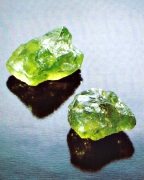 |
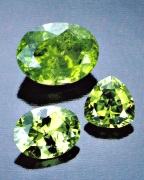 |
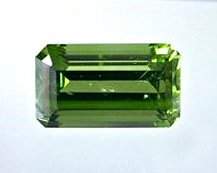 |
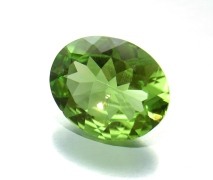 |
| ���t�@�Qcm�@�ƃ��[�X�@10.5, 3.9,
2.9ct �����@�͖k�ȁ@��k Xuanhua, Hebei, China |
15��9mm�@9.1ct �����@�L���� �����R Xi Kuang Shan, Guangdong, China |
2.65ct
11.0x8.8mm �����@�g�я� Jilin, China�@ | |
�@
�@�����̃y���h�b�g��1979�N�ɖk���̖k��150km�͖̉k�ȁA�鉻(Xuanhua)�ɃA���J��������̗n�⒆�ɕ�Ύ��̃y���h�b�g�c��������܂����B
2cm�i20ct�j�̑傫���̓����Ȓc��ő��10�J���b�g���x�̃��[�X�������܂��B
�����2000�N�ȍ~�͗ʂ͏��Ȃ��̂ł����L���Ȃ̐����R (Xi Kuang shan) �Y�Ɩk���̋g�яȎY�ƁA�l�X�ȎY�n�̔������y���h�b�g�����s��Ɏp�������܂��B
�@
�@In 1979, gemmy perido cluster in the alcali basalt lava flow was discovered at Xuanhua, 150km north-east of Peking. China. Faceted stone of maximum 10ct is obtained from 2cm(20ct) rough.
�@Since 2000, faceted peridots from Xi Kuang Shan, Guandong and Jilin are seen in the market.
�m���E�F�[ (Norway)
�m���E�F�C�̒��A�x���Q�� (Bergen)�̖k���悻�@200km�ɂ���@�G�[�w�C�� (Åheim)�@�̍z�R�ł̏d�@�ɂ���K�͂Ȟ�S��̌@�@(Peridotite mining at Åheim, Norway)
�ʐ^�@�F�@�����N���Ă���@Diamond Holiday �̃m���E�F�C�҂���
0.32ct 3.6x3.6mm
Söndömre, Norway��Ύ������@35x22x17mm �� ���[�X 1.71ct Ø7.95x7.35mm�@�iGemmy crystal and faceted stone)
Åheim, Norway
�@�m���E�F�[�ASöndömre�̃y���h�b�g�͈ꎞ�̓A���]�i�Ɏ������E�L���̎Y�o�ʂ��ւ����Ƃ̂��ƁB
�ŋ߃����N�����@�h Diamond Holiday �`��̌@�̗��h�@�̃m���E�F�[�҂Ŗ��炩�ɂȂ�܂������A�ʐ^�̂悤�Ɍ��݂ł��d�@�ɂ��A��S��̑�K�͂ȍ̌@���s���A���E���ɗA�o����Ă���Ƃ̂��Ƃł�.
�m���E�F�[�ɂ̓G�N���W���C�g�Ƌ��ɒn���[�����畬�o������S��̂��L�x�ɑ��݂��A�z�R�ł͞�S�Ό����Ђ����낲��Ɠ]�����Ă���悤�ł��B
�������A��S��͕�Ηp�r�ł͂Ȃ��A���ӂ��Ĕ엿�̓Y���ܓ��̎Y�ƍނƂ��č̌@����Ă��܂��B
�@���炭�A���Ă͕�Ηp�ɃJ�b�g����Ă���������������Ǝv���܂��B
���A�H���Ȋ��ɂ͒l�i�̈����y���h�b�g�͕�Ηp�r�ւ̍̌@�Ɖ��H�͐�i���ł͓���̎Z�����܂���B
�@���ݎs��Ńm���E�F�[�Y�̃y���h�b�g����������@��͖ő��ɂ���܂���B
�@�O�D�R�Q�J���b�g�̃��[�X�͏������Ȃ��瓧���x���������������A�����Ȃ��̂ł��B
1.71�J���b�g�̃��[�X�́A�G�[�w�C���Y�̌����̕�Ύ��̕������X�������J�ŃJ�b�g�������̂ł��B
�@��ⓧ���x���Ⴍ��L�����܂݁A�W�{���ł͂���܂����A�M�d�Ȏ����ł͂���܂��B
Once�ANorway�@was the second largest pridot producer, next to San Carlos, Arizona, U.S.A.
Norway is widely covered with peridotite mass, erupted together with eclogite and, peridt clusters are easily found at mining sight.
Today, there is a larg cale mechanical operation at Åheim, about 200km north from Bergen, for industrial purposes.
Mining and cutting peridot for gemstone business has been ceased., long time ago.
Today, Norwaygian peridot is rarely seen in the gem market.
�@A 0.32 carat stone from Söndömre, Norway is a rare exmaple of quality peridot with high luster.
1.71 carat hazy stone from Åheim is a sample quality , but a valuable specimen from rare locality.
�G�`�I�s�A (Ethiopia)�@
�@�G�`�I�s�A�œ암�̃\�}���A�����ɋ߂�������1992�N�����Ƀy���h�b�g����������܂����B
�@������ΎR�e�����Ƀy���h�b�g���������Ă��܂��B
��Ύ��̒c��͍ő��2�O�����قǂ̑傫���ł��B
�@�P�j�A�o�R�Ŏ�Ƀh�C�c�̃C�_�[��I�[���@�[�V���^�C���Ō�������Ă��܂��B
�@In mid 1992, peridot was doscovered at southern Ethiopia in the desert near Somalian boarder. Peridot is crystalized in the basalt bomb. Gemmy crystal fragments have mximum 2 gramms. Recovered stones are faceted mainly at Idar-Oberstein, Germany.�l�p�����[�X(Square loose) 2.76ct
Megado, Ethiopia
�X�[�_��(Sudan)
�@
�@�X�[�_���ŕ�Ύ��̃y���h�b�g���̂��Ƃ��������ȕ͂���܂��A�A�t���J��n�a�тɘA�Ȃ�ΎR�n�т��甭������Ă��s�v�c�ł͂���܂���B
�@�ʐ^�̕W�{��2006�N4����99�ŖS���Ȃ����A�����J�̍z���w�ҁBF. �|�[���m�̃R���N�V�����̕��o�i�ł��B
�@��ⓧ���x�Ɍ����܂����A�X�[�_���Y�̋M�d�ȕW�{�ł��B
�@�|�[���m��������肵�����ŕ�Ύ��̂��̂��J�b�g���ꂽ�Ǝv���܂��B
�@�����A�W�{�̑唼�͕�Ύ��ł͂Ȃ��̂Ŗ{�i�I�ȍ̌@���s���Ȃ��ƍl�����܂��B3.00ct 15.0x7.0mm
Ex. F. Pough collection
�@There are no official reports nor literatures of gem peridot production from Sudan. �@However, considering the geological location that this area belongs to the Great African Rift Valley series, there are great possibility of peridot finds, as well as Kenya and Tanzania. The specimen of 3ct faceted stone of photo is from ex. Frederick Pough collection, great American mineralogist, who has gone in April 2005 at age of 99 years old !!
�@The facetted stone is slightly clouded to be lesser value as gemstone, which might be the reason that commercial mining is not activated.
This stone seems to have been faceted experimentally by Dr. Pough from his own crystal collection.
���F�g�i��(Vietnam)
�@1993�N���Ƀ��F�g�i���암�̃����h���ƒ����̃J���{�W�A�����ɋ߂�
�fia Lai�Ƃ̂Q�����ŕ�Ύ��̃y���h�b�g����������A�ŏ���2�T�Ԃ�100�`200kg���̌@����܂����B
�@�T�����A���H�Ɍ����̂�15�����x�A�����܂肪�T�`10���ŁA���ς̑傫���͂Q�`�U�J���b�g�ł��B
�@�Y��̏ڍׂ͕s���ł����A���]�i�Ɠ���������n��N���Ǝv���܂��B1.60 - 5.56ct �@Lam Dong
�@In mid 1993, two gem peridot localities were discovered in Vietnam : (1) in Lam Dong Province southern Vietnam; and (2) in Gia Lai Province, central Vietnam near the Cambodian boarder. In the first few weeks of operation, the two localities produced an estimated 100-200kg of peridot. The average quality is rather poor, as the stones are highly fractured and included , as well as light in color and about 15% are suitable for fashoning, with weight retention being only 5-10% and average size is about 2-6ct.
�@
�X�������J (Srilanka)
�y���h�b�g(Peridot)
3.62ct 10.0X6.6mm�t�H���X�e���C�g(Forsterite)
0.21ct 4.2x3.0mm���S��S�� (Fayalite)
0.17ct(3.9x3.1mm) 0.08ct 3.1x2.5mm
�@�X�������J�͑��ʂȕ�̎Y�n�ł����A�i�炭�y���h�b�g�͂̕���܂���ł����B
����2�C3�N�A�悤�₭�X�������J�Y�Ə̂���y���h�b�g���s��Ɏp�������܂������A�ڍׂȎY�n�͕s���ł��B
�@�̂�Ă��s�v�c�ł͂���܂��A���������Y�n�̕����X�������J�ŃJ�b�g���������ƌ����\��������܂��B
�@���F�͓̐S�����܂܂��A�قڏ����Ȍ]�_�}�O�l�V�E������Ȃ�t�H���X�e���C�g�ł��B
��Ύ��̃t�H���X�e���C�g�͎��͐��E�ł��ɂ߂ċH�ɂ�����������܂���B
�@�@�X�������J����́A�H�ȕ�Ύ��̓S��S��(Fayalite)����������܂��B
�S���ɕx�ރt�@�C�A���C�g�͈�ʂɂ͕s�����Ȍ����ł����������ꂸ�A��Ύ��̂��̂͑�ϒ������̂ł����A�������ɂ��������Y����X�������J�Ȃ�ł͂̕�Ύ��̕W�{���o�܂����B
�ƌ����Ă��ő��0.2�J���b�g���炢�̑傫���ł�����A�W�{�Ƃ��Ẳ��l��������܂���B
�@�s��ł̓Y�j�ƌĂ�Ă��܂��B�Y�j�Ƃ͈�̉��Ȃ̂��������t�����A�Ƃ肠�������肵�Ē��ׂĂ݂��Ƃ���A�ǂ����y���h�b�g�ł͂Ȃ����Ƃ���ɒǐՂ��āA�悤�₭�I�[�X�g�����A�� Dun�R �Ɉ��� Dunite(�_����S��)�̌�����ǂ݂ł������ƕ�����܂����B
�@���߂���_�i�C�g�ƌ����Ă�������ɂ��搳�͕̂�����Ȃ������͓̂��l�ł�
�@
�@Peridot has never been reported from Srilanka, neither.
Quite recently, peridot from Srilanka appeared in the market. Detailed locality is un known. It might be from other countries and only cut in Srilanka.
�@The colorless stone is a rare gem fayalite, which is found dark non-transparent nodule, in general.
Although small, gemmy crystals of both forsterite and fayalite are rarely found, in Srilanka.
�@Yellowish fayalite�Acalled Dunite, which name derives from Dun Mountain, Australia.
覐Β��̃y���h�b�g (Peridot in meteolites)
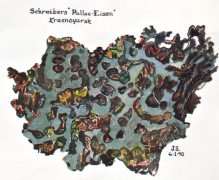 |
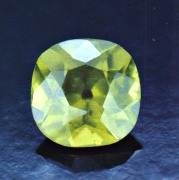 |
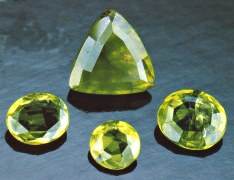 |
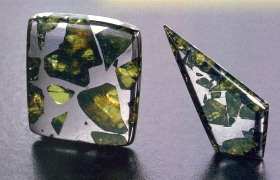 |
| �@�N���X�m�����X�N�ɗ������� �y���h�b�g���܂ރp���X覐� John�@Sinkankas�@�̃X�P�b�` Water color reproduction by John Sinkankas of Krasnoyarsk pallasite |
Eagle Station Pallasite �̃y���h�b�g�@0.42ct Faceted peridot from Eagle Station Pallasite �A�����J���R�j������ American Museum of Natural History |
Esquel�@Pallasite�̃��[�X 0.25�`1.39ct Peridots from Esquel Pallasite |
����i�Ƃ���覓S�Ƌ��Ɍ������ꂽ �G�X�P��覐� �iPolished Esquel Pallasite�j |
�@
�@��S��͒n���̃}���g���̎�v�Ȋ�ΐ����ł��B
���z�n�� �ΐ��Ɩؐ��ƂɊԂɂ��鏬�f���т�,���z�n���o�������Փ˂ŕ��X�ɂȂ����V�̂̂����炩�琬�閳���̔j�Ђ̏W�܂�ł��B
�@���������j�Ђ��d�͂ň������A��C���ŔR���s�����ɗ�����������覐ł��B
�@���̂���,�V�̓����̓S�Ɗ����Ȃ�ΓS覐́A1749�N�ɃV�x���A�̃N���X�m�����X�N�ߍx�ɗ�������680k����覐ׂ��h�C�c�̒n���w��,�@Peter�@Simon�@Pallas�@�Ɉ���,�p���T�C�g�@(Pallasite)�@�ƌĂ�܂��B�@
�@�V�x���A�̃p���T�C�g�ɂ̓j�b�P���ƓS����Ȃ���������̌��Ԃ߂�悤�ɓ����ȃy���h�b�g�̌������܂܂�Ă��܂����B
�@�傫�Ȍ������̃y���h�b�g�͕�Ƃ��ăJ�b�g����A���̌�����E�e�n�Ŕ������ꂽ�p���T�C�g����J�b�g���ꂽ�y���h�b�g�̃��[�X���s��ɏo��邱�Ƃ�����܂��B
�@�L���Ȃ��̂ł�1887�N�ɃA�����J,�P���^�b�L�[�B��Eagle�@Station�Ŕ������ꂽ�p���T�C�g����J�b�g����A�e�B�t�@�j�[��ΓX�̃N���c���m�ɂ����1900�N�̃p���̍��۔�����ɏo�i���ꂽ0.42�J���b�g�̃��[�X������A���݂̓A�����J,�j���[���[�N�̎��R�j�����قɓW������Ă��܂��B
�@�܂�1951�N�ɃA���[���`���̃G�X�P���Ŕ������ꂽ覐����30�قǂ̃��[�X���J�b�g���ꐢ�E�̍z���t�F�A�Ȃǂɏo���܂����B
�@�ɂ߂Ē��������[�X�̂��߃J���b�g������400�h���ƁA�����̃A���]�i�Y�Ɣ�ׂ��100�{���̒l�i�ł����A���̋H�������炷��Βl�i�͂����ĂȂ��悤�Ȃ��̂ł��B
�@Peridotite is the typical rock-forming mineral that represent major part of earth's mantle. The asteroid belt which lies between Mars and Jupiter consists of numerous broken pieces of heavenly bodies which are formed by collisions in the early stage for solar-system formation�BMeteorite comes from this asteroid belt and fell down to the earth. Among various types of meteorite, there is a chondrodite which consists of rocks and iron is named pallasite. The name derives from German geologist who first described the type specimen - a 680kg mass found near the town of Krasnoyarsk, Siberia, in 1749. Transparent peridots in pallasites are facetted gemstone, as shown in photos. A peridot piece recovered from meterolite in 1887 at Eagle Station, Kentacky, U.S.A. was facetted by famous gemologist Jeorge F. Kunz of the Tiffany and Co., displayed at 1900 Paris International Exposition and now housed in the American Museum of Natural History.
About 30 pieces of faceted stones recovered from pallasite, discovered at Esquel, Argentine in 1951 appeared in world's gemstone market at price of US$400 per carat.
�y���h�b�g�̕]�� (About peridot's market value)�@
�@3500�N���̐̂���m���Ă���y���h�b�g�ł���,�����ł͗]��l�C�������Ƃ͌������A�s���Ƃ����v���Ȃ��قǂ̒Ⴂ�]����������Ă��Ȃ��̂������ł��B
�@�����̃A���]�i�Y�ł̓J���b�g�����肹������10�h���A�r���}�Y�̍ŏ�̂��̂ł�100�h���A�Ƃ������R�̒l�i�ł��B
�@�ߔN�p�L�X�^���⒆���A���F�g�i�����A���E�e�n�ɐV�����Y�n����������ċ����ʂ��������Ƃ͂����A�S�Ă𑫂��Ă��N�Ԃ̋����ʂ�100���J���b�g�ɂ͒B���Ȃ��Ɛ��肳��܂��B�@
�@����̓_�C�A�����h��T�t�@�C�A,�G�������h�Ɣ�ׂėy���ɏ��Ȃ��A���r�[�Ɠ����̐����ł��B�@
�@��̉��l�̊�Ƃ��ċH�������グ���܂����A�y���h�b�g�Ɍ����Ă͍ł������ȃ��r�[���̋H���ȕ�ɂ��S�炸,�@�N�Ԑ��S�g��(30���J���b�g)����������Ă��鎇�����ȉ��̒l�i�ł��B
�@�u�₩�Ȏ�t�F����G�������h�̂悤�ȐV�܂ŁA���ɖ��͓I�ȐF�ʂ�������������Ⴂ�]����������Ȃ��������i�������Ƃ͍l�����܂���B
�@�����̓����y���h�b�g�̐l�C���������Ēl�i���}�������������͎̂��Ԃ̖�肾�낤�Ǝv���܂��B
Peridot is the gemstone which has been playing an important role in the history of gemstone since as old as more than 4500 years, while today it is one of the least evaluated. The dominant Arizona peridot of average 1-3ct stones fetched US$10 per carat and the best bigger stone from Burma is valued at most US$100, an unreasonable prices. Although supply source has increased from new localities such as ; Pakistan, China, Vietnam etc., the total annual production does not exceeds one million carats, that is far less than diamond, sapphire nor emerald and is the same level as ruby, but is priced as the lowest level as amethyst, which production is several hundreds tonnes(3 billion carats !!)�@This is one of the mystery that such attractive colored gemstone is evaluated extremly low level in gemstone market. It will be a matter of time that people recgonize the real beauty of peridot and rush to seek for peridot.
�����ƓV�R�̃t�H���X�e���C�g(Synthetic and natural forfesterite)
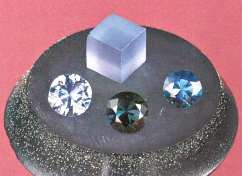 |
 |
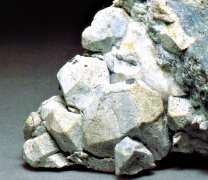 | |||
| �`���N�����X�L�[�@�ō������ꂽ �N�����Y���̃t�H���X�e���C�g Chrome doped Czochralski synthetic forsterite �����̂ƃ��[�X�@0.83 - 1.18ct Cube(0.5cm) and faceted stones �O������z�R (Mitsui Mining Industry Inc.) |
���V�ш�@�ō������ꂽ�����@1.8cm Melting zone synthetic foresterite Lawrence�@Livermore�@National�@ Laboratory�@U.S.A. |
�V�R�̃t�H���X�e���C�g���� Natural foresterite crystal �@4x3cm�@Lagazzuolo Val�@Malenco�@Italia |
�V�R�̃t�H���X�e���C�g�iNatural forsterites�j 3.54ct 6.20ct 2.48ct 0.32ct
5.3x3.6mm0.45ct
8.2x3.8mmKukh-i-lal,Pamir Mtns. Srilanka Dattaw, Mogok, Burma
�@�`���̉��w�g�����番����悤��,�y���h�b�g�͞�S�Α��̋�y��S�F�t�H���X�e���C�g�iMg2SiO4�F�]�_�}�O�l�V�E���j�ƓS��S�F�t�@�C�A���C�g�iFe2SiO4�F�]�_�S�j�Ƃ̌ŗn�̂���Ȃ�z���ł��B
�@�t�H���X�e���C�g�̖��̓C�M���X�̍z���w�ҁAJ. Forester�i1739�`1836�j�Ɉ��݂܂��B
�t�@�C�A���C�g�̖��͍ŏ��ɔ������ꂽ�A�|���g�K���̃A�]���X�����̏����AFayal���Ɉ��ޖ����ł��B
�@�V�R�̃y���h�b�g��20�����x�̃t�@�C�A���C�g��80�����x�̃t�H���X�e���C�g�̊����ŎY�o���܂����A�H�Ƀt�@�C�A���C�g�̔䗦��10���ȉ��ƒႭ���F�ŁA�t�H���X�e���C�g�ƌĂ�錋������������܂��B
�@��Ύ��̃t�H���X�e���C�g�͋ɂ߂ċH�ł����A�ߔN�X�������J�A�r���}�A�p�~�[���R���Y�̃��[�X���H�Ɏs��Ɏp��������悤�ɂȂ�܂����B
�@�t�H���X�e���C�g��y���h�b�g�̓`���N�����X�L�[�@�A���V�і@�A���[�U�[�n�Z���̈����グ�@�ɂč�������Ă��܂��B���������Ηp�r�ł͂Ȃ��A���[�U�[�f�q�⌋�������̌����p�Ƃ��Ď����ړI�ō�������Ă��܂��B
�@As seen from composition, peridot is found in nature as the solid solution between magnesium-peridoto : Forsterite(Mg2SiO4) and Iron-peridot : Fayalite(Fe2SiO4) in the olivine group. Foresterite's name derives from English mineralogist, J. Forester(1739-1836) and Fayalite is named from Fayal Island, Portuguese Azores Islands, where first discovered.
�@Although extremely rare, faceted forsterites from Srilanka, Burma and Pamir Mountains are seen in the market.
�@Natural peridot cvonsists of 10-20% Fayalite and 90-80% forstelite and is colored yellow-green-brown. But rarely colorless forsterite with low fayalite percentage of of less than 10% is found.
�@Foresterite and peridot is experimentally synthesized by various method ; Czochralski method, melting zone method and laser abrasion method etc., mainly for laser and maser oscillation device etc.
�@
| Top | Gem�@Hall |